164 Search Results for visual schedule
August 1, 2012
by Carole Zangari -
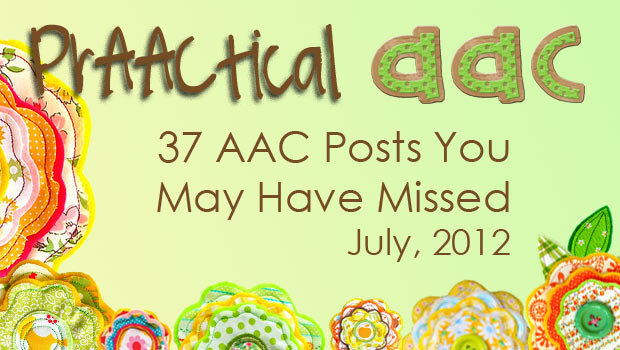
Biennial Conference: ISAAC 2012 PrAACtically There: ISAAC 2012 Day 1 at ISAAC 2012: What You Should Know About AAC’s Expanding Role in Health Care ISAAC 2012, Day 2: AAC Goes to Preschool ISAAC 2012, Day 3: Let the Games Begin ISAAC 2012, Day 4 – The Fives 5+5 Commandments for Speech Output Communication 5 Under-Used Strategies in AAC 5 Online Notebooks Full of AAC 5 Adapted Play Resources for Children with Motor Impairment – PrAACtical Thinking 92 Free or Lite Versions of AAC Apps PrAACtical Alert: Free AAC Evaluation App This Week Visualize 9 Nice Things to Say to Students who AAC PrAACtical Thoughts About Challenging Behavior PrAACtical Resource: Searching for AAC Devices with SpeechBubble AAC Assessment Round-Up 5 Ways to Use Rating Scales to Enhance Communication with AAC PrAACtical Alert: The World’s AAC Conference Comes to You (Well, a little bit of it) Power of the Visual Planner: 20... [Read More...]
July 28, 2012
by Robin Parker -

Some PrAACtical AAC thoughts about challenging behavior: I wonder if it is ok to say that we love seeing challenging behavior during speech-language therapy sessions or observations. Well, I said it, both of us do, because if we really ‘listen’ then we can figure out what to teach that will really help our students. We tend to prioritize our goals into High Priority and General Priority. Challenging behavior and the communication message behind it, definitely falls into high priority. This is because challenging behavior in students limits experiences, limits interaction, and overall limits opportunities for people to get to know you. Consider Challenging Behavior through Communication Glasses Is it really Challenging Behavior? behavior that is or can be destructive or hurtful. Examples include but are not limited to: hitting, biting, spitting, throwing, pounding, etc. (Note: we are not talking about poor eye contact or poor attention to task or even laughing... [Read More...]
July 7, 2012
by Carole Zangari -
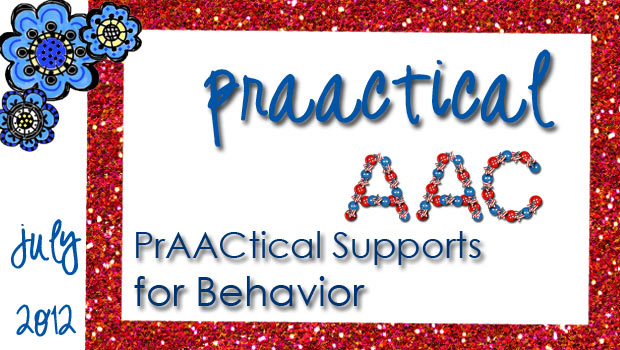
Rachel arrives to therapy tense and upset. Mauro gets frustrated when the clinician presents new activities. Brianna starts to bang the table when demands are placed on her. Zach becomes agitated when he has to wait for something he wants. – Like any set of tools and strategies, AAC works best when the communicator is relaxed, confident, and engaged. Our July Strategy of the Month focuses on PrAACtical Supports for Behavior. We hope to share ideas for planning therapy sessions that help AAC learners stay focused, calm, and engaged. — We’re big believers in the old adage that an ounce of prevention is worth a pound of cure. So, what can we do to prevent or minimize problems like the ones experienced by Rachel, Mauro, Brianna, and Zach? The answers have to do with having clear and appropriate expectations, and using visual and AAC supports effectively. When used consistently, these strategies... [Read More...]
July 2, 2012
by Carole Zangari -

The Fives PrAACtical Suggestions: 5 Ways to Elicit Language Without Asking a Direct Question 5 Tools to Make Aided Language Input Easier “Call Me Later:” 5 Supports for Phone Communication by People Who Use AAC Safety Matters: 5 Resources for People Who Use AAC – PrAACtical Thinking 72 Free and Lite Versions of AAC Apps AAC App Giveaway: It’s a PrAACtical Celebration 7 Apps for Adolescents with Special Needs “Not Dumb Now” (And Actually, Never Was) Pivotal Skills for AAC Intervention: Aided Language Input Before It’s Too Late: A PrAACtical Resource for Emergency Situations PrAACtical Tips for Passing the SLP PRAXIS on the First Try, Part 1 PrAACtical Resources: Making Sense of Picture Symbol Options PrAACtice Fire Safety 25 Under 5: AAC Apps PrAACtical Intervention Ideas: AAC Learning with the Toys, Websites, and Apps You Love PrAACtical Reflections on Father’s Day Introducing RELAAACs: Rubric for Evaluating the Language of Apps... [Read More...]
June 1, 2012
by Robin Parker -
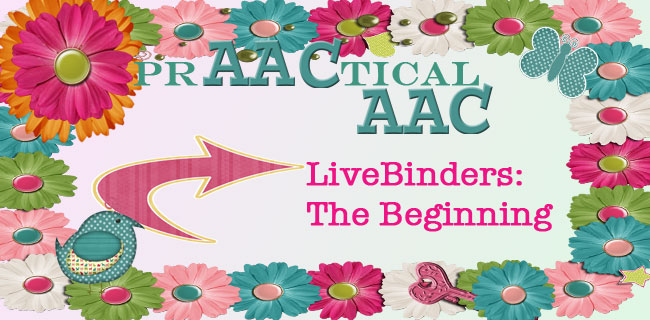
We have always started our collaborative projects with a retreat (usually a day at the beach or park). The retreat usually ends with a project and a plan to meet again. Following the retreat that inspired PrAACtical AAC, we were spending hours upon hours on the computer searching We were using pen and paper to write down urls to sites we wanted to share. We couldn’t believe the great information that was available. So when Carole told me to sit down and said “you have to look at what I found, it’s called LiveBinders“. I can still remember the exact moment. It was like on T.V….. the sun started shining through the window of my living room and music started playing. We couldn’t believe there was a site that was easy to use, would organize all the work we had done, let us look at and use other binders,... [Read More...]
May 26, 2012
by Carole Zangari -
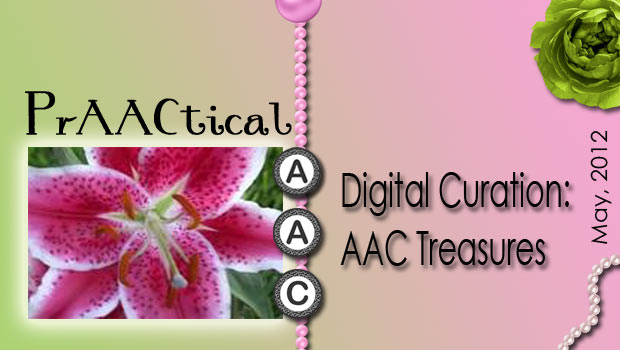
– A curator? Who, me? When a colleague first suggested that the online things we were sharing were part of the digital curation trend, I didn’t quite see it. Yes, I was always on the hunt for sites with quality AAC-related content. Yes, I sifted through those finds carefully to figure out which to keep, which to share, and how to organize it all so that I could actually find it when I needed it. But a curator?! Images of quiet basement rooms and dusty shelves came to mind…not quite the realm of my day-to-day experience. – On closer inspection, though, I began to see what my colleague was saying. Because I teach so many AAC graduate classes fully online, I am always trying to figure out new ways to use technology to get student SLPs engaged and passionate about AAC. It’s been exciting exploring the new web tools over... [Read More...]
May 14, 2012
by Carole Zangari -
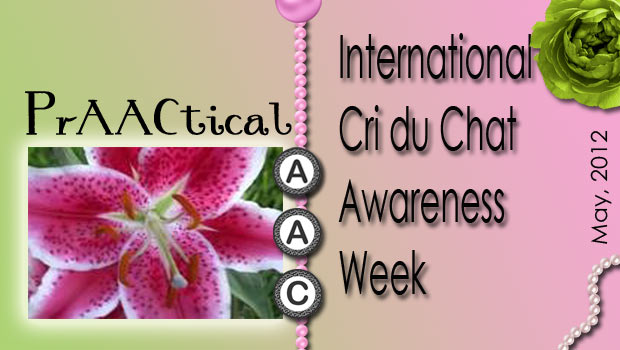
– Today’s post is in honor of the first ever International Cri du Chat Awareness Week and the lovely young lady pictured here (as well as in the brochure linked below). – Cri Du Chat Syndrome (CdCS, also called Lejeune’s syndrome and 5p deletion) is a low incidence genetic disorder caused by a deletion on the short arm of chromosome 5 (5p-). Most children with CCS experience general developmental and communication delays, some of which are quite significant. They tend to have strengths in receptive language. Their speech is often marked by frequent articulation errors, small phonetic inventories, and restricted syllable shapes. Many infants and children with CdCS also have feeding and swallowing difficulties. Children with CdCS have a higher co-occurrence of cleft lip/palate. – 1. 5p- Society (US) and the Annual Conference: Positive Attitude, Reaching New Heights (July, 26-29 in Denver, CO). This group also has a network of... [Read More...]
May 1, 2012
by Carole Zangari -
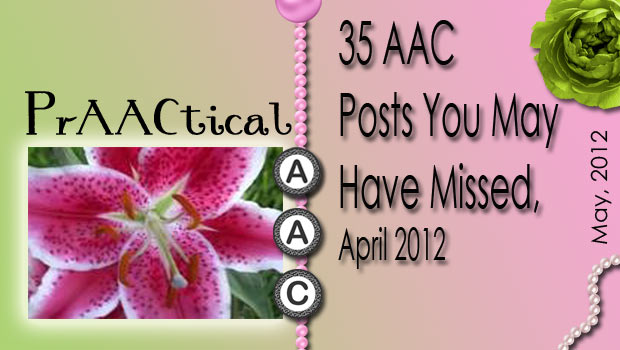
— – – Strategy of the Month From Disney Princesses to Houseplants: More on Building Communication Opportunities 5 Apps for Tempting Commenting and Other Language Functions Go Ape! 10 Commenting Communication Temptations PrAACtical Play: Creating Communication Opportunities with Favorite Toys How to Make Communication Temptations Really Work Mining Preschool Routines for PrAACtical AAC Opportunities. Meaningful Communication Opportunities – The Fives 5 ‘Go-To’ Sites for AAC and Visual Support Downloads 5 Apps for Tempting Commenting and Other Language Functions 5 AAC-Related Facebook Pages/Groups We Love 5 Tools and Tips for Making Transitions Easier 5+ Sites for Free AAC-Friendly Literacy Resources 5 eGames for Switch Users 5 AAC/AT YouTube Channels We Love – PrAACtical Thinking 49 Free or Lite Versions of AAC Apps A Myth About Visual Schedules Lives On PrAACtical Resources: Making Decisions about Reading Accessibility Options PrAACtical Resources: Toolkit for ASD PrAACtical Questions: How Do I Find Good AAC Service... [Read More...]
April 22, 2012
by Carole Zangari -

Transitions can be hard for everyone, whether it is turning off the TV to finish grading papers or leaving a favorite place to go run some errands or following through to finish cleaning out the garage. For people with significant communication difficulties, there can be additional challenges. Here are some of our favorite tools and strategies for making transitions easier for everyone. – Visual Schedules: Our hands-down favorite way of helping people transition smoothly is to make the expectations visual and explicit. Lots of info on making this strategy successful here and here. Timers, timers, and more timers! We love them because, once the routine and expectations are established, they work so beautifully in so many situations. Social stories:Well-written social stories shared via high quality intervention can go a long way in preventing or minimizing transition issues. Transition items: Lots of families, teachers, and SLP have had success using objects... [Read More...]
April 1, 2012
by Carole Zangari -
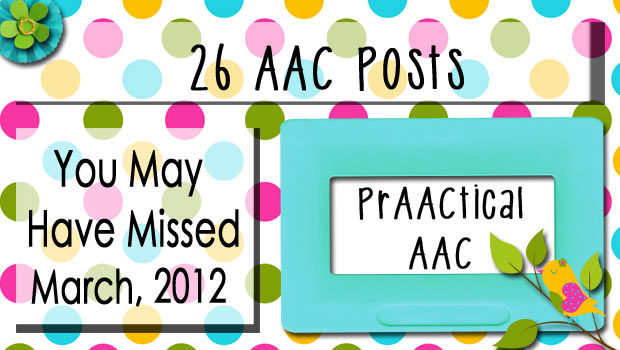
If March was as busy for you as it was for us, then you may have missed some of these posts. Grading exams, meeting with students, clinical paperwork, grant-writing, teaching, travel, etc. Know wonder we’re tired! Enjoy this bit of catch-up. – The Fives 5 Great Resources for Helping Individuals with Vision and Hearing Loss AAC on the Go: 5 Tips for Traveling with AAC Tech it Up’- 5 Visual Schedule Apps 5 Resources for AAC Data Collection 5 Tips to Make AAC Assessments Run Smoothly 5 References to Support AAC Use – PrAACtical Thinking 1. The Secret to Succeeding At Anything 2. National Quilting Day & Employment 3. AAC and March Madness 4. Games are More Than Fun… Gaming for ALL 5. Hearing the Knock 6. HijAACked! AAC & Anti-Bullying with Stand Tall, Mary Lou Melon! 7. Emergencies and Resources to Help 8. Random Acts of Kindness 9. Do... [Read More...]









